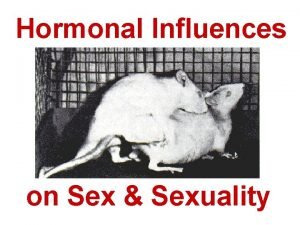Gender Roles and Sexuality Gender learned socialized differences
















- Slides: 16

Gender Roles and Sexuality • Gender: learned, socialized differences • Sex: biological differences • Gender role: societal expectations about appropriate behavior for women and men • Gender-role stereotypes: overgeneralized (and often inaccurate) beliefs about what males and females are like.

Gender Differences • Males – more active – more developmentally vulnerable – better spatial skills – more physically aggressive • Females – verbal skills develop earlier – more compliant – rate selves higher in nurturance/empathy – Flexibility and fine motor skills – More relational aggression

Mental Rotations

Gender Differences – Parsons, 1955 • Expressive role: kind, nurturant, cooperative and sensitive to needs of others. • Instrumental role: dominant, independent, assertive and competitive.

The Development of Sex-role Concepts and Stereotypes: • By age 3, children typically begin to assign occupations, toys and activities to the stereotypical gender. • By age 5, associate personality traits with males and females. • By age 8/9 years this stereotypical knowledge is well developed.

The Development of Sex Role Behavior: Behavior is sex-typed before development of ideas about sex roles and stereotypes. • By 18 - 24 months, preference for sex-typed toys, some months before normally identifying own gender. • By age 3, prefer own-sex playmates and more sociable with same sex children, but do not yet have gender stability. • By age 6, gender divide in friendships is marked: gender segregation.

Theories of Sex Role Development • • Psychoanalytic Social learning theory Cognitive Developmental Biological Influences

Psychoanalytic Theory Freud: relied on the concept of identification, that occurs (in his theory) at around 4 or 5 years. His theory not compatible with empirical findings.

Social Learning Theory Bandura and Mischel

Social Learning Theory • Differential reinforcement: encouraging sex -appropriate play and discouraging cross-sex play. • Modeling • Parental expectations selffulfilling prophecies

Empirical support for social learning theory • Parents respond more positively when their children play with sex typed • Such differential reinforcement is particularly pronounced in boys • Strongly gender stereotyped parents lead to earlier development of gender stereotypes in children. • Fathers are especially uncomfortable with “girlish” behavior in their sons

Cognitive Developmental Theories Kohlberg: Cognitive developmental theory of gender typing: 3 phases 1) Child acquires basic gender identity (2 -3 years of age) 2) Gender stability (4 -5 years of age): gender does not change 3) Gender constancy (6 -7 years of age): superficial changes in appearance don’t alter gender

Evaluation of Cognitive Theories • Once the child realizes that s/he is a boy/girl forever, s/he is highly motivated to behave in the way that is expected for that gender. • Thus, one would expect systematic same sex imitation only after full gender constancy has developed. • But, children show clear differential sex role behavior, long before achievement of full understanding of the gender concept.

Biological Factors in Gender Differences • Hormones – testosterone-aggression – Money: high levels of androgens masculinization of females; more tomboyish • Brain lateralization – men’s brains are more lateralized than women’s

The Red Nails Devon is a 3 -year-old boy who enjoys spending time at his grandmother's house. One Friday, he went to visit Grandma for the entire weekend. On Friday evening, he watched in fascination as Grandma painted her nails with red polish. He asked if she would paint his nails as well. Grandma saw no harm in it, so she painted Devon's nails. On Saturday, Grandma and Devon spent the day at the mall and enjoyed supper together at Mc. Donald's. Devon especially enjoyed playing with the other children in the Mc. Donald's play area. On Sunday, they went to church together. On Sunday evening, Devon's father came to pick him up. When he saw the red polish on Devon's nails, he became very upset and demanded an explanation. Grandma explained what had happened and explained that she saw no harm in painting the boy's nails. Dad disagreed and became angrier when he learned that Grandma had taken Devon out in public with the red polish on his nails. "If you're going to turn the boy into a sissy, he can't visit you any more, " Dad said. He demanded that she remove the polish immediately and severely scolded Devon for asking to have his nails painted.

The Red Nails • Why does the father react as he does? • Do you relate more to the grandmother or the father? • Would your opinion change if the child was 6 years old? • To what theory of gender role development does the grandmother subscribe? • To what theory of gender role development does the father subscribe?
 Socialized medicine
Socialized medicine Chapter 10 sex gender and sexuality
Chapter 10 sex gender and sexuality Androgen insensitivity syndrome
Androgen insensitivity syndrome Gender and sex difference
Gender and sex difference Snow white 1812
Snow white 1812 Development of gender roles
Development of gender roles Integration of gender roles in school and curriculum
Integration of gender roles in school and curriculum Strategic gender needs and practical gender needs
Strategic gender needs and practical gender needs Pretest: growth, development, and sexuality
Pretest: growth, development, and sexuality Is there any bias in gender roles based on the excerpt
Is there any bias in gender roles based on the excerpt Ancient gender roles
Ancient gender roles Why are gender roles important
Why are gender roles important Are gender roles a social construct
Are gender roles a social construct Gender representation in casablanca
Gender representation in casablanca What does the bible say about gender roles
What does the bible say about gender roles Gender roles theory
Gender roles theory Indus valley gender roles
Indus valley gender roles































